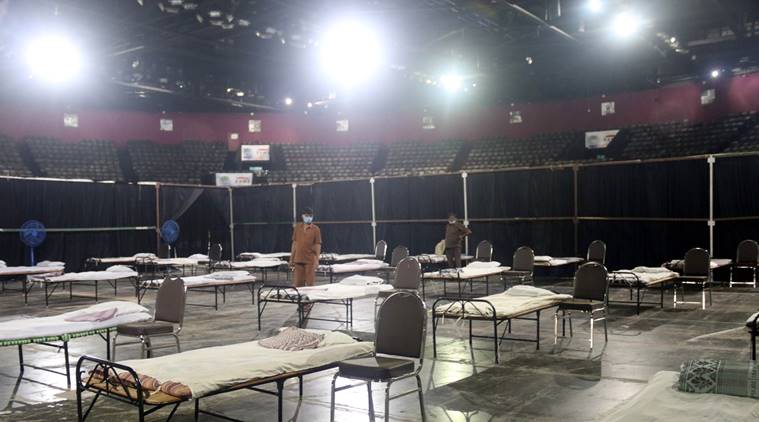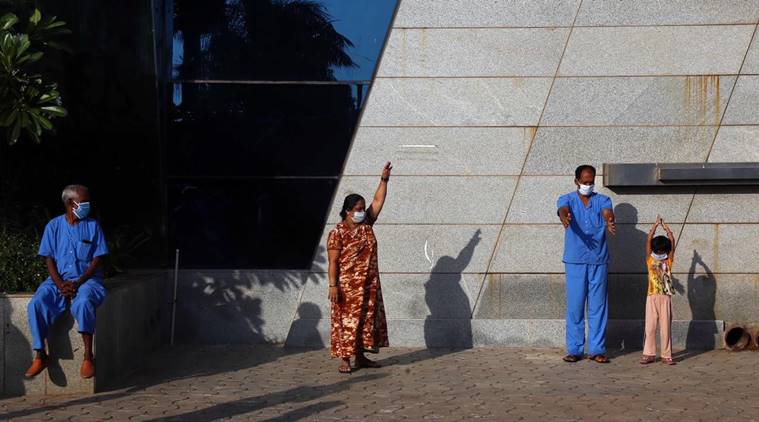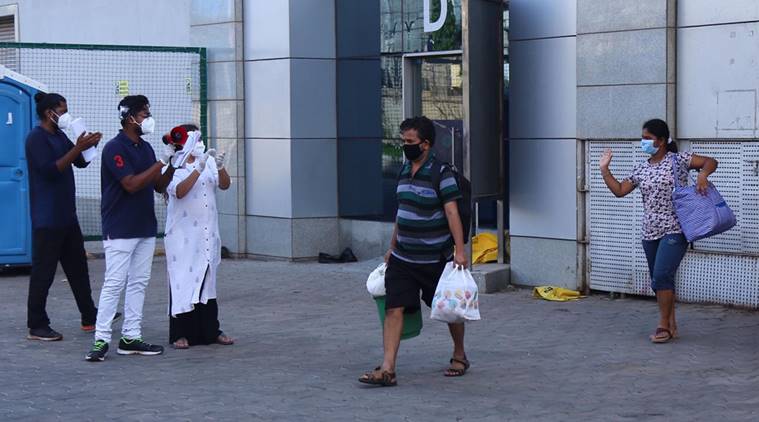 Worli’s Dome is now a 500-bed isolation centre for asymptomatic patients. (Express Photo By Ganesh Shirsekar)
Worli’s Dome is now a 500-bed isolation centre for asymptomatic patients. (Express Photo By Ganesh Shirsekar)
A sample collector steps into the small cubicle that resembles a telephone booth, with metal panels on two sides, a sheet of glass in front and two hand-sized holes with large rubber gloves attached. He is not wearing PPE, there is no need for it. The cabin is equipped with filters designed to keep out fine particles and purify the air.
After cleaning his hands with sanitiser, and donning a pair of disposable gloves, the collector puts his hands into the large rubber gloves, reaches out with a swab to the person sitting on the other side, and draws a sample from his nose and throat.
Welcome to the Dome.
Only weeks ago, this was one of the largest event venues in the country at over 38,000 sq ft and a seating capacity for 8,000-10,000, at the National Sports Club of India in Worli, with a sweeping view of the Arabian Sea. Today, it is a 500-bed isolation centre for asymptomatic COVID-19 patients.
Equipped with a “contactless” sample collection facility and diagnostic “self-clinic”, everything is done across a glass panel, with patient and medical professional communicating over cordless phones.
On Monday, there were 260 patients in the facility that is jointly run by the Brihanmumbai Municipal Corporation (BMC) and well-known bariatric and laparoscopic surgeon, Dr Mufti Lakdawala, founder of Digestive Health Institute in Mumbai. A team of 10 doctors and 30 nurses from the institute, and 30 volunteers and BMC officials, monitor patients round the clock.
Mumbai has over 25,000 isolation and quarantine beds in government and private hospitals. But with the city emerging as Ground Zero of the COVID-19 outbreak, with over 5,000 cases so far, the Dome is being described as “a model unit”.
“Here, patients are provided all facilities, from consultation to food and entertainment. We have tied up with two local pharmacies, too,” said Sharad Ughade, the assistant municipal commissioner of G-South ward, which covers Worli, Prabhadevi and Lower Parel, and has recorded 600 cases, the highest among all wards in the city.
 Asymptomatic inmates exercising outside the dome. (Express photo by Nirmal Harindran)
Asymptomatic inmates exercising outside the dome. (Express photo by Nirmal Harindran)
The Dome is also part of a network of mega facilities being added to the city’s arsenal. A 1,000-bed quarantine and isolation facility is under construction at the BKC exhibition ground. Then, there’s a 1,240-bed facility with oxygen cylinders at the Goregaon exhibition centre, apart from 250 BMC schools. Officials say they are gearing up to tackle an estimated 75,000 cases by May-end.
At the Dome, the BMC is getting oxygen cylinders for each of the 500 beds, with the possibility of symptomatic patients being admitted soon, portable ICU units, and 100 beds in open areas of the NSCI stadium.
Inside, there are four sections — senior citizens, males, females and families. There’s a fan for each bed, 50 water dispensers, 70 toilets and showers, and four LED TV screens.
 An inmate practices yoga at the NSCI dome in Worli. (Express photo by Nirmal Harindran)
An inmate practices yoga at the NSCI dome in Worli. (Express photo by Nirmal Harindran)
On Monday afternoon, playback singers Roop Kumar Rathod and Sunali Rathod sang for the patients through live feed broadcast on the screens. In the evening, a batch of patients in blue uniform stepped out in the open area for fresh air, and to walk and exercise with a yoga instructor.
Currently, officials say, patients in the facility are from the hotspots of Worli-Koliwada, Jamata Nagar slums and BDD chawls. At least 20 patients from the BYL Nair hospital have also been admitted.
Lakdawala’s team, meanwhile, is starting a pilot programme for bracelet sensors that will be worn by patients like a smart watch from May 1 to go “completely contactless”.
So far, ten sensors have been procured, which will monitor pulse rate, BP, respiratory rate, saturation level, blood sugar and ECG. They will send an SMS to doctors if levels fall below a set limit. There will also be a video attached to the screen that will instruct patients on how to attach and use oxygen tubes and masks.
“The idea is to create what Dr Lakdawala calls a hospotel, ie, converting every hotel or lodge into a hospital, and monitor every patient remotely,” said Ughade.
“The biggest problem of this disease is contact. And the more healthcare personnel we lose, the worse it gets. All the traditional forms of healthcare, where the doctor touches you, are gone. Only 5-7 per cent of COVID patients need ICU. And right now, all hospitals are full of the other 95 per cent people, that’s why they are unable to admit serious cases,” Lakdawala said.
 Inmates leaving the quarantine centre in Worli. (Express photo by Nirmal Harindran)
Inmates leaving the quarantine centre in Worli. (Express photo by Nirmal Harindran)
“The idea is to convert every tertiary care hospital into state-of-the-art tertiary facilities. And all the 95 per cent can be monitored remotely in hotels or lodges. Patients are also happy for 14 days since they are taken care of in hotels,” he said.
At the Dome, apart from daily monitoring, patients undergo retests after seven days. For those testing negative, a retest is done in three days. The samples are dispatched either to a private lab or the BMC-run facility at Kasturba Hospital.
In G-South ward so far, around 1.5 lakh people have been screened, and 125 patients discharged as of April 25. And according to Ughade, the BMC has been able to “break the chain”.
“Now, we are targeting to isolate more suspected cases from congested areas. A mobile van dispensary, or a mobile OPD, will go door to door with doctors to conduct thermal scans and check for symptoms. The suspected cases will then be put in the quarantine facility, while others will be administered medicines,” Ughade said.
Aaditya Thackeray, the Worli MLA, has credited health and municipal officers for slowing the spread in the area. “Worli model is a story of hope,” he tweeted.
At the Dome, a senior citizen who was among 26 patients discharged Monday summed it up: “When my family was brought here, there was fear of unhygienic conditions and we didn’t know if we would survive the disease. But here, doctors and officials took care of us like family.”